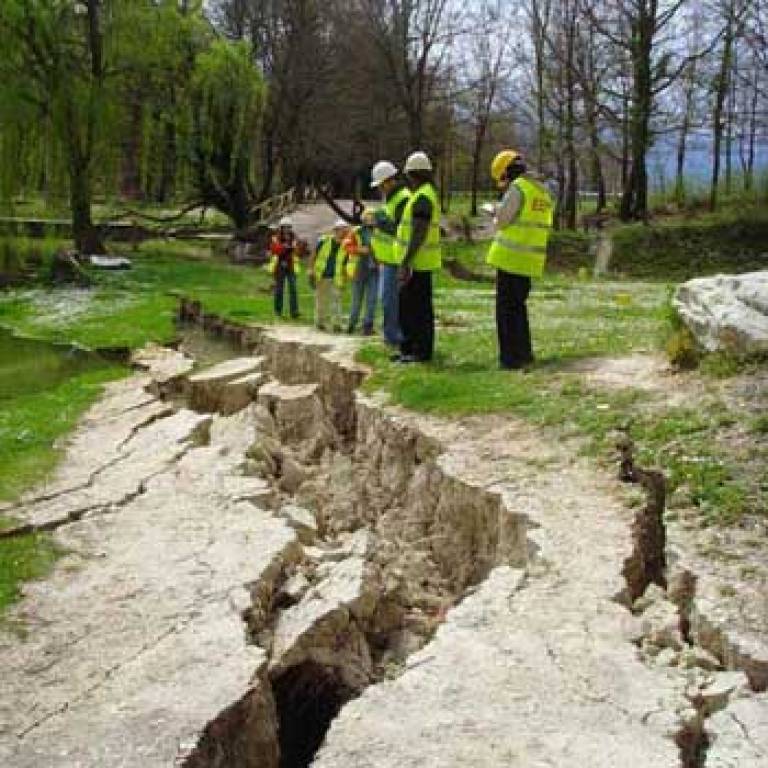L'Aquila anniversary highlights need for better buildings
6 May 2010
Italy should prepare for the possibility of earthquakes larger than last year's disaster at L'Aquila and take steps to reinforce poorly constructed buildings.

That's the conclusion of new research from the Aon Benfield UCL Hazard Research (ABUHRC) published to mark the first anniversary of the earthquake, which killed nearly 300 people in April 2009.
The earthquake, which struck Italy's Abruzzo region on 6 April, led to the collapse of over 15,000 buildings, leaving 1,500 people injured and about 34,000 living in emergency shelters.
It resulted in the highest death toll in the European Union since the 1980 Irpinia earthquake, also in Italy, and the highest economic loss due to seismic activity since the 1999 Athens earthquake.
Researcher Dr Ioannis Papanikolaou, who is based at the ABUHRC, has studied what happened in L'Aquila and identified key ways to assist seismic hazard assessment, planning and recovery, including:
- The L'Aquila earthquake was not a surprise - it occurred in an area characterised as having high seismic hazard based on traditional maps and historical record
- The event ruptured a small segment of the fault system and not one of the major postglacial fault scarps in the area. This explains the minor primary surface ruptures which did not exceed 4km in length or 10cm in displacement. Other surrounding faults, however, can produce much stronger earthquakes that can generate primary surface ruptures of 15-20km long and maximum displacements exceeding 1m
- Satellite imagery showed that the earthquake resulted in a maximum subsidence of 25cm and uplift of 10cm
- Bedrock geology and basin effects played a decisive role in the damage pattern even at short distances. For example, communities that were only 1.5km apart recorded differences in shaking intensity of up to 3.5 degrees (ranging from no damage to poor-quality buildings in one community to severe damage to specially designed structures in the neighbouring community)
- The majority of damage in the villages occurred due to poorly constructed and old masonry buildings, while collapses in reinforced concrete buildings were relatively few in number. However, despite the fact that their reinforced concrete frames remained intact they experienced crumbling masonry and collapsed fill walls. This suggests that the nature of the infill walls and their attachment to the frame of the buildings should be re-examined
- The moderate 2009 L'Aquila earthquake has highlighted the vulnerability of historic centres, both in Italy and across much of the Mediterranean region, providing a valid argument for major retrofitting programs to avoid far worse seismic disasters in future.
Dr Papanikolaou said: "The L'Aquila earthquake is an important case study for two key reasons. Firstly, moderate magnitude earthquakes occur more often than strong events in settings where the earth's crust is being stretched. For example, Italy experiences a couple of moderate damaging events every decade compared to one or two stronger earthquakes every century.
"Secondly, the frequency of these types of moderate earthquakes is combined with their proximity to population centres which presents a high risk. Given the moderate size of the earthquake, the high level of structural damage and the sizeable casualty figures, emphasis must be placed on ensuring that the historical centres are better prepared next time as larger earthquakes are a possibility."
For more information about the work of the ABUHRC, follow the link above.
Image: Members of the Earthquake Engineering Field Investigation Team (EEFIT) inspect the aftermath of the earthquake in L'Aquila last year (credit: EEFIT)
Links:
UCL context
The Aon Benfield UCL Hazard Research Centre provides a conduit for the transfer of cutting-edge natural hazard and risk research, practice and innovation from the academic environment to the business world, government and international agencies.
Related stories:
Earthquake experts focus on helping Haiti
Earthquake experts investigate Italian disaster zone
 Close
Close

